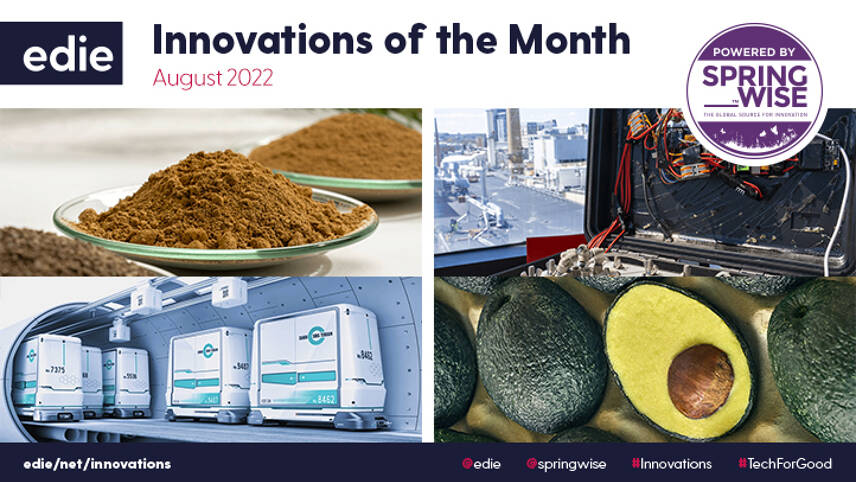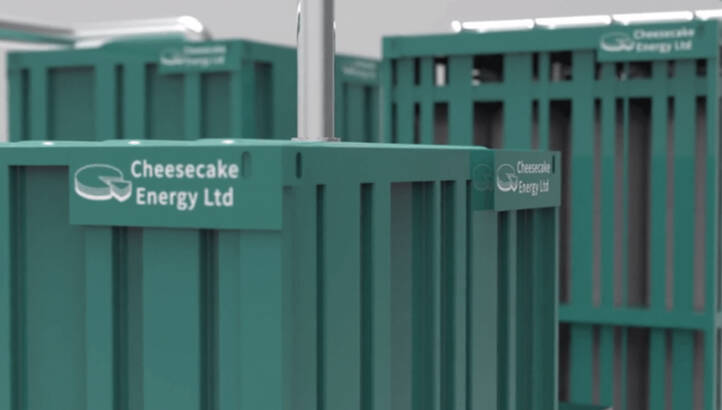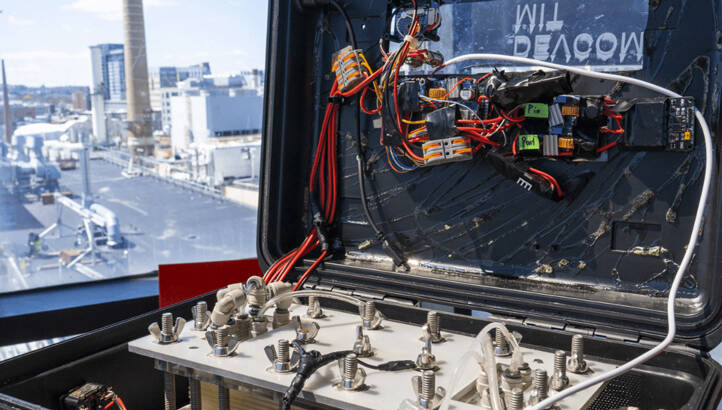Register for free and continue reading
Join our growing army of changemakers and get unlimited access to our premium content

Innovations featured this month could help solve sustainability challenges like critical mineral use for battery production and food system sustainability
Our current fossil-fuel-based energy system has delivered abundant power for decades – but at the expense of the environment. As we transition to a new energy system, it is essential that we don’t repeat the mistakes of previous generations and ignore the potential impacts of new technologies. Batteries are one area of potential concern, as the rapid adoption of renewables and electric vehicles (EVs) leads to a scramble for raw materials such as lithium, nickel, and cobalt. What will be the unintended consequences of this modern-day gold rush? Our first two innovations this month address this emerging challenge by offering alternative methods of energy storage.
Anyone who has followed the news recently will be painfully aware of the threat posed by drought and water scarcity – an issue exacerbated by climate change, the principal unintended consequence of fossil fuels. Our second two innovations tackle this issue from different directions. A portable desalination device aims to boost the supply of drinking water, while a sustainable avocado alternative could reduce the demand for a particularly water-intensive crop.
Crops need more than water to survive, they also require sunlight. Or at least they have until now. A new ‘artificial photosynthesis’ process could make it possible to grow crops in the dark, saving outdoor space. And our final innovation could save a different type of space: road space. By moving cargo transportation underground a new subterranean network could reduce the strain on road systems.
Read on to find out more about edie and Springwise’s six innovations of the month for August 2022.
Plant-based batteries
Image: Stora Enso
Batteries will play an important role during the energy transition, not just for EVs, but also as a means of storing energy from variable sources such as solar and wind. But existing battery technologies have their own limitations. For example, one of the challenges associated with lithium-ion batteries is the use of graphite, which is either mined or derived from fossil-fuel-based materials. Another problem specifically affecting Europe is the fact that the continent must import the key raw materials used in batteries. This not only adds to the carbon footprint of battery manufacturing, it also raises supply security concerns.
Now, biomaterials company Stora Enso and battery manufacturer Northvolt are teaming up to explore a promising solution to these problems. The partnership’s plan is to swap graphitic carbon for lignin in battery design. Lignin is a polymer derived from the cell walls of plants, and Stora Enso has used it to create an anode material called ‘Lignode’. This will then be used as a key component in batteries designed by Northvolt.
The lignine for the Lignode will be extracted from wood from sustainably managed forests in the Nordic region. As a result, it will be possible to create the world’s first industrialised battery featuring anode sourced entirely from European raw materials. This will help the sustainability and resilience of Europe’s rapidly expanding battery industry.
Heat and air energy storage
Image: Cheesecake Energy
Chemical batteries are just one way of storing energy. In fact, energy storage ideas come in all shapes and sizes. For example, Cheesecake Energy, a University of Nottingham spin-out founded in 2016, has developed a new system that uses heat and compressed air to store energy.
The organisation’s ‘eTanker’ storage system contains electric motors that are powered by the grid. These motors drive a compressor, which creates both pressurised air and a substantial amount of heat. Crucially, the heat and compressed air are stored separately. A thermal store captures the heat, while the air is held in an air tank where it cools down to ambient temperature. When the time comes to use the energy stored in the system, the process is effectively put into reverse. The heat in the thermal store is used to re-heat the compressed air which expands and drives a generator creating an AC electric current.
The novel approach offers a number of benefits, particularly over lithium-ion batteries. The first is durability. Lithium-ion batteries typically last around five to ten years and lose capacity over time. By contrast, Cheesecake Energy claims its system has a lifetime of 25 years with very low degradation. Second, the eTanker can provide power for up to twelve hours at a time, whereas batteries provide power in short bursts. Finally, and perhaps most notably, Cheesecake Energy claims that its system can achieve costs 30-40%lower than the cheapest batteries currently on the market.
Portable desalinators
Image: M. Scott Brauer
Water scarcity is a growing issue around the world. Unicef estimates that, today, 1.42 billion people— including 450 million children—live in areas of high or extremely high water vulnerability. And regions as diverse as the UK, the Po Valley in Italy, the southwestern United States, East Africa, and southwest China are currently experiencing drought conditions. Desalination—a process that turns saltwater into drinking water—is an established technology, but normally requires industrial-scale facilities.
This could be about to change, however. Researchers at the Massachusetts Institute of Technology (MIT) have developed a portable desalination unit that works at the touch of a button. Most importantly, this system is small-scale (around the size of a briefcase) and does not require filters or high-pressure pumps.
The device uses less energy than a typical phone charger and can be powered using existing portable solar panels – which can be purchased online for as little as $50. The team envisages that the technology could be particularly useful for remote communities such as those living on small islands. It could even be used to generate drinking water on ships during ocean voyages.
A more sustainable avo-alternative
Image: Central Saint Martins / Arina Shokouhi
Avocados are healthy and extremely popular, but they are also a particularly resource-intensive crop. Every year, 11 billion pounds of avocados are eaten around the world – many of them produced in Mexico. And producing all those avocados uses up an unsustainable amount of water – it takes around 320 litres of water to grow and ship a single avocado. Also, the carbon footprint of that single avocado is about the same as a whole kilo of bananas.
To solve this problem, Central Saint Martins graduate student Arina Shokouhi has invented an avocado substitute that is more resource-friendly – the Evocado. Like the avocado, the Evocado is pale green, creamy, and healthy. It is made from a combination of mostly broad beans, hazelnut, apple, and rapeseed oil. Because the Evocado was designed for the British market, all of the ingredients are grown in Britain and sourced locally to reduce food miles.
To develop the recipe, Shokouhi worked with food scientist Jack Wallman from the University of Nottingham’s Food Innovation Centre. The Evocado is surrounded by a fake skin made from natural and naturally-coloured wax, which is not only biodegradable and compostable, but can also be upcycled into a candle once the insides are eaten. At the centre of the Evocado is a large nut, instead of a stone.
Artificial photosynthesis
Image: Marcus Harland-Dunaway/UCR
Through photosynthesis, plants convert water, carbon dioxide, and energy from sunlight into sugars that they use to grow biomass. This process has been the basis of the food chain for millions of years, yet it is surprisingly inefficient. In fact, only about one per cent of the energy found in sunlight actually ends up in the plant. Now, scientists at the University of California Riverside have found a way to improve on mother nature’s method by bypassing biological photosynthesis entirely.
The research team used a special type of electrolyser—a device that uses electricity to obtain useful molecules from raw materials—to convert carbon dioxide into a substance called acetate. Plants can directly consume this substance to grow, without the need for photosynthesis. The team used solar panels to generate power for the electrocatalysis.
The artificial system converts sunlight into food far more efficiently than biological photosynthesis. And experiments have found that mushrooms, yeast, and green algae could all be grown in complete darkness using the electrolyser-derived acetate.
Underground transport tunnels
Image: Cargo Sous Terrain
According to the EPA, in 2015, the US logistics industry moved 49.5 million tonnes of goods worth nearly $52.7 billion (around €51.5 billion) every day, which is more than 56 tonnes of freight per person per year. This is a large contributor to air pollution, and projections are that by 2025, 23.5% more goods will be transported across the US. That means more fuel consumption and more emissions. How can cargo be transported without damaging the environment?
Switzerland might have the answer. The country’s new Cargo Sous Terrain (CST) logistics system is a privately funded initiative aiming to create an underground freight-transport network that is sustainable and efficient. The system comprises a network of tunnels and caverns in which freight vehicles are transported on magnetic levitation tracks.
The first part of the network will stretch more than 70km in length, running from Härkingen-Niederbipp to Zurich. The system is due to be fully operational by 2031, with the full network completed by 2045.
Springwise is the leading global innovation intelligence platform for positive and sustainable change. For the last 20 years, it has been uncovering and curating the most innovative thinking and ideas on the planet. Today, with a library of more than 11,000 global innovations, Springwise is trusted by thought-leaders, entrepreneurs, investors, educators, and tech disruptors as the leading source of inspirational ideas that matter. Visit Springwise.com








Please login or Register to leave a comment.